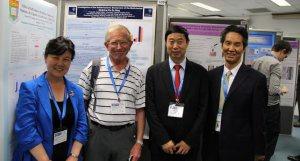IOVS:一种可快速监测卒中患者的新型视觉检测手段
科学家们已经研发出一种快速、简便、廉价的视觉检测方法,可发现卒中患者大脑哪部分受损以及受损程度,这有可能挽救更多的生命。检测要求患者注视一个装置大约十分钟,这样在卒中早期,即使患者肢体及言语功能丧失也很实用。
根据WHO,卒中是目前世界上第六大常见死亡原因,占所有死亡人数的4.9%。在澳大利亚,每年卒中所致死亡约9000人,住院治疗35000人。来自视觉中心和澳大利亚**大学Corinne Carle博士和Ted Maddess教授说,这对于医生快速,准确的诊断和治疗卒中具有非常重要的意义。因为早期治疗可以大大提高存活率和恢复的机会。
使用Maddess教授视觉中心小组及澳大利亚公司研发的TrueField分析仪,研究人员检测了瞳孔对LCD屏幕图像的反应。对每只眼睛视野中的24个区域进行红色、绿色和黄色混合刺激。使用2台红外线摄像机记录瞳孔的即时反应,然后通过计算机进行分析。之所以会选择红色、绿色和黄色,是因为这三种颜色是在大脑不同区域进行处理的。
Carle博士解释,“新的检测方法能自动追踪患者瞳孔对不同颜色的反应,并且可以显示损害是否位于进化的”‘新脑’或‘旧脑’。新脑旧脑的区别很重要,因为‘旧脑’,或称为中脑,控制心律和血压,因此如果你发现中脑已受损,那么你需要更积极的治疗患者,因为中脑受损死亡风险更高。另一方面,‘新脑’即大脑皮质受损可能会导致一部分视野永久失明,或者患者的思维、言语和运动出现障碍,但其死亡风险较低”。对哺乳动物来说,皮质或“新脑”,是最新的进化区,可使人类能够区分红色和绿色。另一方面,“古老的”中脑却是红-绿色盲,但可以检测到黄色。Carle博士说,“如果瞳孔对红色变为绿色没有反应,那么我们知道是皮层受损。当接受黄色刺激时可用类似道理来解释”。
“这种检测方法在青光眼或1型糖尿病患者视野检测中已证实有效,我们对针对卒中患者的色彩刺激进行了相应的调整。”Ted Maddess教授指出,该检测方法会是不同类型脑扫描的补充。“CT扫描会告诉你哪里出血,但它并没有把一切都告诉你。举例来说,扫描过程中,大脑特殊部位的血液会被清除,或正常组织因水肿在扫描图像中则显示功能下降。扫描检查也可能会遗漏微小损伤或发生在中脑部位(此处扫描不佳)的损伤。” 而这正是该检测方法有用之处。
每一个视细胞都与大脑的不同部分相连,通过检测视野的特定区域,医生可以检查大脑相应部位的功能是否正常或受损。这种检测方法可用于监测卒中患者的恢复,Maddess教授说:“目前,除了脑扫描,没有其他便宜的、常规的检测可对疾病治疗后的改善程度进行量化评估。卒中患者复发风险非常高,所以医生准确的评估患者的恢复显得尤为重要。”
“TrueField分析仪较小,价格适中,检测只需花费10分钟,”他说。研究小组将协同神经科医生一起,将于今年2月开始卒中患者的临床试验。
由Corinne F. Carle, Andrew C. James 及Ted Maddess共同完成的研究<The pupillary response to color and luminance variant multifocal stimuli>”一文发表在最新一期《眼科与视觉科学研究》(Investigative Ophthalmology & Visual Science)杂志上。
The pupillary response to color and luminance variant multifocal stimuli
Abstract
Purpose:We are developing multifocal pupillographic objective perimetry (mfPOP) to assess localized changes in function within visual pathways. In this study we investigate novel mfPOP stimuli designed to target neural components from either or both the sub-cortical pupillary luminance response and the cortically driven color response. Methods:Pupillary responses of 12 subjects were recorded to eight mfPOP stimulus variants (protocols). Forty-eight visual field test-regions (24/eye) were stimulated concurrently with uncorrelated sequences of either high or low luminance-contrast, luminance- plus color-contrast, or equiluminant color-exchange, stimuli. Stimulus pulses were of 50 ms duration and were presented at mean intervals of 4 s/region. Test durations were 4 or 8 minutes, therefore estimated responses were derived from 60 or 120 stimulus presentations to each test-region. Results:Pupillary response amplitudes were more influenced by luminance-contrast than the color-contrast of stimuli; response delays, however, were more closely linked to the proportion of color- vs. luminance-contrast in each protocol. Significant differences (p<0.05) in amplitudes but not delays were present between all three high luminance-contrast protocols and a low luminance-contrast luminance protocol, regardless of color content. The reverse pattern was observed between the equiluminant color-exchange protocol and this same low luminance-contrast luminance protocol. Only the low luminance-contrast plus color-exchange protocol differed significantly from the low luminance-contrast luminance protocol in both measures. Conclusions:Two protocols, utilizing low and high luminance-contrast plus color-exchange, were identified as likely to incorporate both cortical and sub-cortical response components, and were deemed potential candidates for further investigation in clinical studies.
本站所注明来源为"爱爱医"的文章,版权归作者与本站共同所有,非经授权不得转载。
本站所有转载文章系出于传递更多信息之目的,且明确注明来源和作者,不希望被转载的媒体或个人可与我们
联系zlzs@120.net,我们将立即进行删除处理
热点图文
-
牛津大学:心速宁胶囊作用机制研究成果发表
2015年5月19日,由澳大利亚药理学会和英国药理学会主办的澳-英联合药理...[详细]
-
GM制药Epidiolex获FDA孤儿药资格
2月28日,GW制药宣布美国FDA授予该公司用于治疗儿童Lennox-Ga...[详细]


